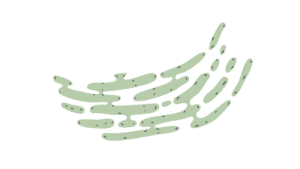Know in one minute about the Endoplasmic reticulum
|
Introduction
The endoplasmic reticulum (ER) is a large network of membrane-bound tubes and sheets. ER varies in appearance in different cells, it looks like long tubules or round vesicles. The ER membrane is similar in structure to the plasma membrane. Its presence in cells was first reported by Garnier in 1897 and its structure and functions were explained by Porter, Claude, and Fullam in 1945.
Position in Cell
ER occurs in between the Plasma membrane and the nuclear membrane. It’s also called a cytoplasmic vacuolar system.
Structure of Endoplasmic Reticulum (ER)
ER consists of the following parts
1. Vesicles
- This type of ER is made with vesicles. These are round oval-shaped structures. They are well-developed in protein synthesis cells.
2. Cisternae
- This part of ER is made with long, thin, flat, unbranched-shaped vesicles which are called cisternae.
These are arranged in parallel with the nucleus in the cytoplasm. These are present in protein synthesis cells like the pancreas, Liver, and brain cells.
3. Tubules
- Is composed of Smooth walled and variously branched tubules.
- Found in which cells are involved in the Synthesis of cholesterol, hormones, steroids, etc.
- There are two types of ER, namely
Rough endoplasmic reticulum (RER)
Smooth endoplasmic reticulum (SER).
- RER have particles called ribosomes. The presence of ribosome RER looks rough. The ribosomes, which are present in all active cells.
- These are the sites of protein synthesis. This synthesized protein transports to various places in the cell depending on need.
- The SER helps in the production of fat or lipids. These proteins and lipids help in building the cell membrane. This process is called membrane biogenesis.

The function of the endoplasmic reticulum
1. Mechanical support
It diffuses into the cytoplasm as an aqueduct and divides it into small compartments and provides mechanical support to the colloidal matrix of the cell.
2. Exchange of Materials
The membranes of ER are semipermeable. The cell membrane of ER acts like a segregation apparatus; it regulates the exchange of osmotic pressure in the cell and the cytoplasmic matrix in the cell and the central part of the cavity of the ER.
3. Enzyme activities and cellular metabolism
The membranes of ER have many enzymes. Its membranes provide a surface for the metabolic reaction of cells.
4. Conduction of Intra cellular Impulse
Ionic gradients and electric potentials are present across the cell membrane.
The sarcoplasmic reticulum is present in the sarcoplasm of linear muscle.
It acts as an intracellular conducting system as it transmits impulses from the outer layer of the muscle to its inner parts.
5. Intracellular transport
ER acts as a transport system inside each cell. Its membrane acts as an important transport mechanism for molecules and ions coming in and out of each cell.
6. Formation of Nuclear membrane and cell plate
At the time of cell division, a new nuclear membrane is formed by ER. Some segments or fragments of ER participate in cell division for the formation of the cell plate.
7. Function as a cytoplasmic framework
The ER functions as a cytoplasmic framework providing a surface for some of the biochemical activities of the cell.
8. Detoxification
In the liver cells of vertebrates, SER detoxifies many poisons and drugs.
9. Synthesis of other biomolecules
SER is involved in the Synthesis of cholesterol and steroids in the gland.
Carbohydrates and Lipids Synthesis.
SER synthesized phospholipids for the cell membrane.
10. Synthesis of glycogen
In Liver glycogen synthesized which cell where smooth ER is well developed. So it’s clarified that glycogen Synthesis has a major relationship with smooth ER.
11. Transportation of message from genetic material
ER helps in the transfer of genetic material information of DNA from the nucleus to the cytoplasm and cytoplasmic organelles. Which controls the Synthesis of protein, Lipids, and carbohydrates in the cytoplasm.
Importance of ER
In the formation of other cellular organelles
ER is important for the formation of other cellular organelles like lysosomes and peroxisomes.
1. For Synthesis of Protein
The rough endoplasmic reticulum contains ribosomes. Ribosomes synthesized protein and transport it to other organs according to needs.
2. For Synthesis of Lipids
The smooth endoplasmic reticulum is involved in the Synthesis of Lipids. Lipids and proteins both are body-building blocks.
3. Synthesis of hormones
SER is important for the Synthesis of steroid hormones.
4. Metabolism of drugs
SER is involved in the metabolism of drugs, besides supplying Ca2+ for cellular functions.
Rough endoplasmic reticulum (RER)
Due to the presence of ribonucleoprotein protein (ribosome) its appearance is rough that’s why it’s called rough endoplasmic reticulum.
A major function of ribosomes in the rough endoplasmic reticulum is the biosynthesis of proteins for export to the outside of the cell and proteins for incorporation into cellular organelles such as the endoplasmic reticulum, Golgi apparatus, plasma membrane, and lysosomes.
These types of cells are found in pancreatic cells, plasma cells, goblet cells, and liver cells.
Smooth endoplasmic reticulum
SER appears smooth because ribosomes are not attached to its surface. They have the sites of fat or lipid Synthesis.
This type of ER is found in cells that do not actively participate in protein synthesis like White blood cells, Muscle cells, spermatocytes, interstitial cells, fat cells, etc.
Difference between Rough Endoplasmic reticulum and Smooth endoplasmic reticulum
Features |
Rough Endoplasmic Reticulum |
Smooth Endoplasmic Reticulum |
Surface |
Its surface is rough due to the presence of ribosomes. | Its surface is smooth. |
Ribosomes |
Present. | Absent. |
Pores |
Pores are present in the region of attachment of ribosomes. | It does not contain pores. |
Product |
Products formed over its surface pass into its lumen due to the presence of pores below each ribosome. | Products formed on its surface do not pass into the lumen as pores are absent. |
Structure |
It has more flattened sacs called cisternae. Tubules and vesicles are few. | SER has more tubules and vesicles. |
Position |
RER lies dipper in the cytoplasm and it is generally associated with the nuclear membrane. | It is peripheral and generally associated with plasma membranes. |
Function |
It takes part in the Synthesis of proteins and enzymes. | SER has enzymes to control the Synthesis and metabolism of glycogen lipids, steroids, and vitamins. |
Formation |
RER can be formed from a nuclear envelope. | SER can be formed from RER. |
Enzymes |
Enzymes for detoxification are absent. | SER has enzymes for detoxification. |
Membrane assembly |
It provides protein for membrane assembly. | It is a site for membrane assembly. |
Ribophorins |
RER contains ribophorins that allow ribosomes to attach to its membrane. | It does not contain ribophorins. |
Position wrt cytoplasm |
Near the cytoplasm. | It is near the cell membrane. |
Q&A
1. Smooth endoplasmic reticulum
Have smooth surfaces because they do not contain ribosomes. It is the site of Lipid Synthesis.
2. Smooth endoplasmic reticulum function
Production of the new cellular membrane.
3. What endoplasmic reticulum do
Mainly involved in protein and Lipid Synthesis.
4. What endoplasmic reticulum
ER is the network of membranous tubules, consisting of membranes with a rough appearance in some areas and smooth in other places.
5. Smooth endoplasmic reticulum function in animal cell
In animal cells, SER is responsible for the Synthesis of cholesterol, glycerides, hormones, and steroids.
6. Where is the rough endoplasmic reticulum located
The rough endoplasmic reticulum is mainly located near the nucleus and Golgi apparatus.
7. Are endoplasmic reticulum in plant and animal cells
Found in both plant and animal cells. It is important for the Synthesis of materials and the production of Lipids and proteins.
Written By: Richa Pachori
References
Essentials of Biochemistry, Pankaja Naik
